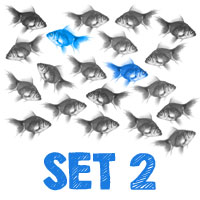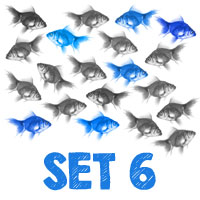
Signs That Are Close... But Not the Same - Set 11
This article is part of our “Signs That Are Close... But Not the Same” series, which highlights signs that look similar, but have different meanings.
The ASL signs shown below look similar, but are not the same. There are many ASL signs that when produced look similar, but in fact have a completely different meaning. Below you will find examples of such signs. Watch closely to see if you can see the differences. In addition, watch my eyebrows, look to see when I tilt my head or lean my body in a certain way, even what my mouth is doing. These nuances are called inflections and trust me, inflections matter.
1. Several vs. Few
SEVERAL and FEW both start with the S handshape on the non-dominant side of the body and then move across to the dominant side of the body ending in a W handshape when signing FEW and a 4 handshape when signing SEVERAL. You can remember FEW ends with the W handshape because the word FEW ends with a W. FEW ends in the W handshape, which has 3 fingers out, while SEVERAL ends in the 4 handshape, which has four fingers out because SEVERAL is more than a FEW.
These signs originated from the French sign for PLUSIEURS (several). The extension of the fingers in the sign originally followed the French counting system and symbolized counting several items.1
 |
2. Use vs. Get Used To
There are many times when an English word may have multiple meanings and when there are multiple meanings, often there are multiple signs to represent each meaning. A common example of this is with the English word “fly” - fly can have multiple meanings and there are different ways to sign each meaning. Signing Savvy uses what we call our “as in” to differentiate between meanings. There are three versions of fly in the Signing Savvy dictionary and they all use different signs: FLY (as in "fly in an airplane”), FLY (as in "the insect”), and FLY (as in "a bird flying”). USE is an another example where it’s important to think about the meaning because to USE something is not the same as to GET USED TO something.
USE (as in "to use or utilize") is signed with the U handshape moving in a clockwise motion on the back of the non-dominant hand. You can remember a U handshape is used because USE starts with the letter U. This sign is also used to say WEAR in English. Some people find it confusing that the same sign is used for USE and WEAR, but the origin of this sign from the French sign for HABITUDE (habit) helps explain the dual usage. The French words habitude (habit), usage (use), utile (useful), and utilizer (use) have related meanings, which is why the sign was used to mean USE. "The alternative meaning of ‘wear’ likely stems from the false association of the English word habit with the French word habit (clothes)."1
USE (as in "to get used to") is signed the same as CUSTOM or TRADITION - the hands move down to the waist as the top, dominant hand closes from an open 5-handshape to a S-handshape. The downward movement while signing GET USED TO shows consistency.
USE (as in "to use up”), USED TO (as in "used to or in the past”), and USED (as in "second hand") also have different meanings, and use different signs, from the examples of USE (as in "to use or utilize") and USE (as in "to get used to") shared in this comparison. USED TO (as in "used to or in the past”) is also shown in the next comparison below.
 |
3. Long Ago vs. Used To
The signs for LONG AGO and USED TO (as in "used to or in the past”) are an example that shows emphasis matters. LONG AGO has a bigger movement to show it was farther in the past than when you are talking about something you USED TO do.
 |
4. Introduce vs. Invite
These signs both use open B handshapes, however, INTRODUCE uses two hands and INVITE uses one.
When signing INTRODUCE, think of the two hands as representing bringing two people together and they are introduced.
The sign for INVITE (as in "to invite someone") also can be used to mean EMPLOY, HIRE, INVITATION, GREET, and WELCOME. Think of the one-handed motion as a welcoming gesture when making an offer, rather it is of greeting or employment. This sign is also a directional sign. The hand would move away from the body if you were asking to be invited. See the sign INVITE (as in, "to invite me”).
 |
5. Problem vs. Difficult
PROBLEM and DIFFICULT are similar because they both use two hands in bent V handshapes. This "double hooked handshape is used in a family of signs to convey notions of hardness, both physical and mental."1 In addition to PROBLEM and DIFFICULT, the signs for HARD (as in, "difficult”), and BONES (as in, "bones in the body”) use this handshape.
The sign for DIFFICULT, with the up and down hand movement, is almost identical to the French sign for PIERRE (stone), which originated from the old French sign for DUR (hard).1 When signing DIFFICULT, think of the symbolism of the handshape and how this sign evolved from the meaning of something being hard.
When signing PROBLEM, think of the two hands colliding as they are encountering a problem or difficulty. You can also think about trying to fit puzzle pieces together to solve a problem. This sign may have evolved from the French sign for PROBLÈME (problem, difficulty) and the related sign COMPLICATION (complication) where the hands fold and refold together. "The metaphor of ‘folding something to complicate it’ motivates the French word compliqué (complicated), which comes from the Latin complicare (fold)."1
 |
How can I figure out the difference between signs on my own?
If you see two signs that look close, but not the same, and you’re not sure, you may use Signing Savvy features to help you figure out the difference. All of our signs have sign descriptions and memory aids that members may access. Reading the sign description and memory aids for the signs will help you figure out the small differences between them that your eyes don’t catch at first. We also recommend using the pause and slow motion feature to slow down the video, so you may take a closer look. These features are available to Signing Savvy members.
Take a look, it's in a book!
These examples are aligned with the Visual Discrimination section of Lesson 7 (page 85) from Lessons and Activities in American Sign Language by Brenda E. Cartwright and Suellen J. Bahleda. Check out the book for more ASL Activities and watch for more examples from this series: “Signs That Are Close... But Not the Same.”
Resources
Signing Savvy is a participant in the Amazon Services LLC Associates Program, an affiliate advertising program designed to provide a means for sites to earn advertising fees by advertising and linking signingsavvy.com to Amazon properties. That means Signing Savvy may contain affiliate links. If you make a purchase after clicking on an affiliate link, your cost will be exactly the same regardless, but Signing Savvy will automatically receive a small commission. Your support is greatly appreciated and helps us continue to improve Signing Savvy!
ADVERTISEMENTS
 Brenda Cartwright is a Coda, seasoned interpreter, a master teacher, well known presenter, and author of several best selling sign language and interpreting textbooks from the RID Press. For 35 years Brenda was the Chair of the Sign Language Interpreter Program at Lansing Community College in Lansing, Michigan.
Brenda Cartwright is a Coda, seasoned interpreter, a master teacher, well known presenter, and author of several best selling sign language and interpreting textbooks from the RID Press. For 35 years Brenda was the Chair of the Sign Language Interpreter Program at Lansing Community College in Lansing, Michigan. Signs That Are Close... But Not the Same - Set 2
Signs That Are Close... But Not the Same - Set 2 Signs That Are Close... But Not the Same - Set 6
Signs That Are Close... But Not the Same - Set 6 Signs That Are Close... But Not the Same - Set 10
Signs That Are Close... But Not the Same - Set 10







Alex BTuesday, August 6, 2019
This is AWESOME. Thank you all so much for providing such great resources. I use this app every single day and it's proven to be such an incredible resource. Thank you thank you.